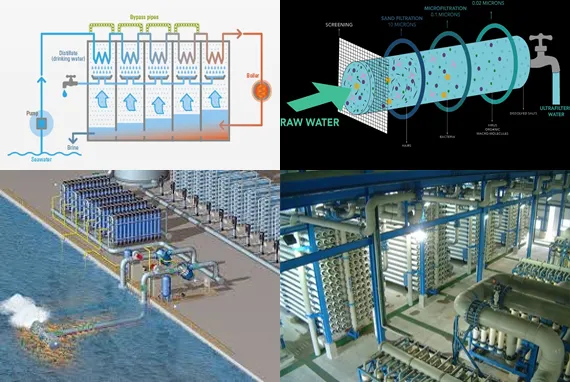We are recognized and leading Seawater Desalination Plant Manufacturers in Ahmedabad, Gujarat, India. Between droughts, natural disasters and the large-scale redistribution of moisture threatened by climate change, the need for new sources of potable water grows with each passing day. Billion people may not have enough drinking water to satisfy their daily needs. One of the possible solutions to this problem is desalination, namely treating seawater to make it drinkable. However, removing salt from seawater requires 10 to 1000 times more energy than traditional methods of freshwater supply, namely pumping water from rivers or wells.

The only available water is seawater, then you'll need to desalinate the water; that is, you'll need to reduce the salt content of the water. One way to desalinate water is through reverse osmosis with a reverse osmosis desalinator. This filtration process uses pressure to force water through a membrane. The solute (salt) remains on one side of the membrane, while the pure solvent (freshwater) passes to the other side. The solvent (in this case, water) moves from an area of high solute concentration to an area of low solute concentration. As its name indicates, this process is the reverse of normal osmosis, in which a solvent moves with no added pressure from an area of low solute concentration to an area of high solute concentration. Not only does a reverse osmosis desalinator remove salt from water, but it also eliminates harmful bacteria and microorganisms.
The multiple-effect distillation (MED) process is the oldest but a very efficient desalination method. Instead of the term “stage”, the multiple evaporators inside an MED plant are called “effects”. In this method, the seawater undergoes boiling in multiple stages without supplying additional heat after the first effect. The evaporators are arranged either (a) horizontally [horizontal tube evaporator (HTE) with evaporated seawater sprayed outside the tube while the heating steam is condensed inside the tubes] or (b)vertically [ long vertical tube evaporators (VTE) with boiling seawater falling film inside the tube while the heating steam is condensed outside the tubes]. For the first effect, the seawater gets preheated inside the evaporator tubes and reaches boiling point. The tubes are heated externally by steam from a normally dual purpose power plant. Only a portion of the seawater applied to the tubes in the first effect is evaporated. The remaining feed water is fed to the second effect, where it is again applied to a tube bundle. These tubes are in turn heated by the vapour created in the first effect. This vapour is condensed to produce fresh water, while giving up heat to evaporate a portion of the remaining seawater feed in the next effect at a lower pressure and temperature. The MED specific power consumption is below 1.8 kWh/m3 of distillate, significantly lower than that of MSF, which is typically 4 kWh/m3 To improve the efficiency of the MED process, a vapour compressor is added before the first stage to boost up energy carried by the vapour. This process is termed as vapour compression (VC). Normally, it is recommended to use multiple stages in this process, as VC system with multiple effects gives increased performance ratio, decreased power consumption and maximum utilization of heating source